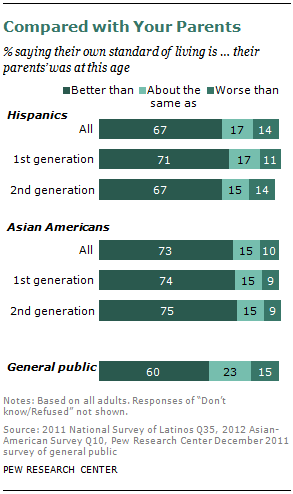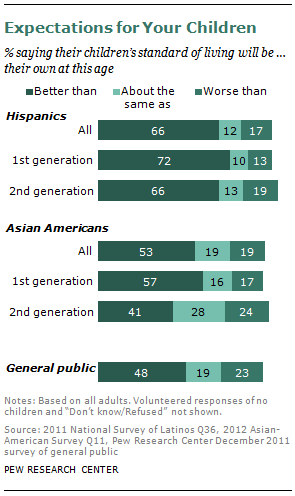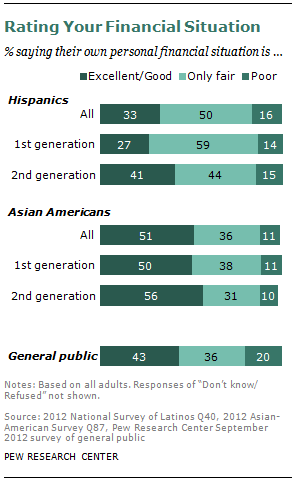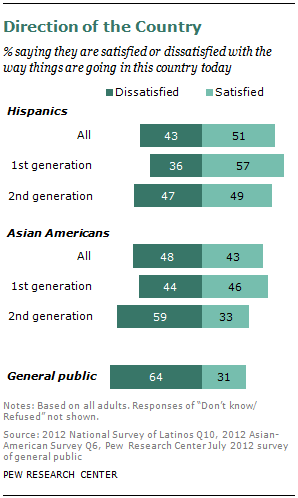America’s immigrants and the adult children of immigrants are different in many ways but nearly identical in one: Overwhelming majorities of both groups see themselves as better off than their parents were at the same stage of life, according to an analysis of recent Pew Research Center surveys conducted with a nationally representative sample of Hispanics and a separate representative survey of Asian Americans.
This chapter also looks at how first- and second-generation Hispanics and Asian Americans assess their personal finances and their satisfaction with the direction of the country as a whole.
Second-generation Hispanics are more upbeat about their personal financial situation than are Hispanic immigrants, consistent with their better financial outcomes shown in Chapter 2. Among Asian Americans, however, there are much less pronounced differences in median household income for immigrants compared with the second generation, and the two generations give a similar assessment of their financial situation.
Clear generational differences emerge when it comes to evaluations of the U.S., however. Second-generation Hispanics and Asian Americans are, on average, more dissatisfied about the direction of the country than the immigrant generation in their respective race or ethnic group. Latino and Asian immigrants are more positive about the direction of the country than is the general public overall. Second-generation Asian Americans tend to resemble the general public in views about the direction of the country.
Standard of Living Comparisons
 There is a strong tendency to see one’s own standard of living as better than that of one’s parents at the same age; this pattern holds regardless of generation.
There is a strong tendency to see one’s own standard of living as better than that of one’s parents at the same age; this pattern holds regardless of generation.
About seven-in-ten (71%) first-generation Hispanics say they are better off than their parents were at the same age; a roughly equal percentage (67%) of second-generation Hispanics say the same.
Both first- and second-generation Asian Americans give similar assessments of their standard of living compared with their parents at the same age. Three-quarters of first-generation (74%) and second-generation (75%) Asian Americans say they are better off than their parents were at the same age.
Compared with the general public, a greater share of second-generation Asian Americans see themselves as having a better standard of living than their parents at the same age; the same tendency is found among second-generation Hispanics, but it does not reach statistical significance.
 Expectations for one’s own children down the road, however, tend to be more tempered among second-generation Asian Americans.
Expectations for one’s own children down the road, however, tend to be more tempered among second-generation Asian Americans.
Most Hispanics expect their children’s standard of living to exceed their own at the same stage of life; 72% of Hispanic immigrants expect their children to be better off than they are now. Expectations among second-generation Hispanics are similar, with two-thirds (66%) predicting their children’s standard of living will be better than their own at the same age in life. Both first- and second-generation Hispanics are more optimistic than the general public overall about their children’s standard of living.
Among Asian Americans, however, there are generational differences in outlook. A majority of Asian-American immigrants expect their children’s standard of living to be better than their own (57%). Second-generation Asian Americans are less sanguine, with 41% predicting their children will be better off, 28% saying their standard of living will be the same and a quarter (24%) saying their children will be worse off than they are now.
These differences in expectations across generations hold even when controlling for age, with younger immigrants (ages 18 to 34) more optimistic about their children’s standard of living than second-generation Asian Americans in the same age group (62% versus 44% expect their children’s standard of living will be better than their own).
Personal Finances
 Perceptions of personal finances tend to vary by immigrant generation among Hispanics but not among Asian Americans. The generational pattern among Asian Americans is in the same direction but does not reach statistical significance.
Perceptions of personal finances tend to vary by immigrant generation among Hispanics but not among Asian Americans. The generational pattern among Asian Americans is in the same direction but does not reach statistical significance.
Hispanics as a whole are worse off, on average, than all U.S. adults in terms of household income.27 And relative to the general public, Hispanics are less positive in how they perceive their personal financial situation. About a quarter of Hispanic immigrants (27%) consider their personal finances to be excellent or good. Ratings of personal finances are better among second-generation Hispanics; 41% of this group says their finances are excellent or good. Ratings of personal finances are about the same among second-generation Hispanics as they are for the general public as a whole.
The portrait for Asian Americans as a whole is quite different. Asian Americans are better off, on average, than all U.S. adults in terms of household income (adjusted and standardized to a three-person household). And more Asian Americans rate their personal finances in positive terms than does the general public. First- and second-generation Asian Americans rate their personal financial situation similarly to each other, however. About half or more of both first-generation (50%) and second-generation (56%) Asian Americans consider their financial situation to be excellent or good; the difference between generational groups does not reach statistical significance. About one-in-ten of each group say it is poor, and the remainder says it is “only fair” or do not give a rating.
Country Satisfaction
 When it comes to perspectives on the U.S. as a whole, about half of Hispanics (51%) and 43% of Asian Americans are satisfied with the direction of the country. Second-generation Hispanics and Asian Americans tend to be more discontented than are immigrants in their respective race or ethnic group.
When it comes to perspectives on the U.S. as a whole, about half of Hispanics (51%) and 43% of Asian Americans are satisfied with the direction of the country. Second-generation Hispanics and Asian Americans tend to be more discontented than are immigrants in their respective race or ethnic group.
Among Hispanics, a majority of immigrants are satisfied with the direction of the country (57%) and 36% are dissatisfied. The second generation is closely divided, with 49% saying they are satisfied with the way things are going in the country today and 47% saying they are dissatisfied.
A similar generational difference is found among Asian Americans. Among Asian immigrants, 46% are satisfied and 44% dissatisfied with the direction of the country. Second-generation Asian Americans are more negative; six-in-ten (59%) are dissatisfied with the direction of the country and a third (33%) are satisfied. This difference in outlook between generations holds even when controlling for age; among 18- to 34-year-olds, immigrants are more satisfied (50%, versus 42% dissatisfied) with the direction of the country than is the second generation (35% satisfied versus 56% dissatisfied).
Compared with the general public, first-generation Hispanics and Asian Americans are more positive about the direction of the country. Second-generation Asian Americans resemble the general public in views about the direction of the country, while second-generation Hispanics tend to be more positive than the general public.


